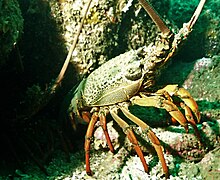Sagmariasus
| Sagmariasus verreauxi | |
|---|---|
 | |
| Scientific classification | |
| Kingdom: | |
| Phylum: | |
| Subphylum: | |
| Class: | |
| Order: | |
| Family: | |
| Genus: | Sagmariasus Holthuis, 1991 |
| Species: | S. verreauxi |
| Binomial name | |
| Sagmariasus verreauxi (H. Milne-Edwards, 1851) | |
| Synonyms[2][3] | |
| |
Sagmariasus verreauxi is a species of spiny lobster that lives around northern New Zealand, the Kermadec Islands the Chatham Islands and Australia from Queensland to Tasmania.[3] It is probably the longest decapod crustacean in the world, alongside the American lobster Homarus americanus, growing to lengths of up to 60 centimetres (24 in).[3]
Names[edit]

The species has many common names in English, including Australian crayfish, common crayfish, common Sydney crayfish, eastern crayfish, eastern rock lobster, green cray, green crayfish, green lobster, green rock lobster, marine crayfish, New South Wales spiny lobster, packhorse crayfish, packhorse lobster, sea crayfish, smooth-tailed crayfish and Sydney crayfish.[2] In Māori, it is called pawharu.[2] S. verreauxi was formerly included in the genus Jasus, but has been separated into a monotypic genus Sagmariasus due to the lack of sculpturation on the abdomen, which is found in all other Jasus species.[3] The name Sagmarasius derives from the Greek σαγμαριον (sagmarion), meaning packhorse, and the genus name Jasus, in reference to the common name "packhorse crayfish".[3]
Human context[edit]
During the early 20th Century, Sagmariasus verrauxi and Jasus edwardsii were one of the cheapest seafoods in New Zealand, with European New Zealanders preferring the taste of British crayfish, Austropotamobius pallipes. Large hauls of Sagmariasus verrauxi were harvested in Northland, either sold cheaply or used as chickenfeed. Sagmariasus verrauxi was occasionally considered a pest that impacted fishing numbers, leading fishermen to occasionally destroy the crayfish. Populations of Sagmariasus verrauxi declined by the 1970s.[4]
References[edit]
- ^ MacDiarmid, A.; Cockcroft, A.; Butler, M. (2011). "Sagmariasus verreauxi". IUCN Red List of Threatened Species. 2011: e.T170017A6708366. doi:10.2305/IUCN.UK.2011-1.RLTS.T170017A6708366.en. Retrieved 19 November 2021.
- ^ a b c T. Chan (2009). "Sagmariasus verreauxi (H. Milne Edwards, 1851)". World Register of Marine Species. Retrieved May 10, 2010.
- ^ a b c d e Lipke B. Holthuis (1991). "Jasus verreauxi (Green rock lobster)". FAO Species Catalogue, Volume 13. Marine Lobsters of the World. FAO Fisheries Synopsis No. 125. Food and Agriculture Organization. pp. 104–106. ISBN 92-5-103027-8. Archived from the original on 2011-06-07.
- ^ Vennell, Robert (5 October 2022). Secrets of the Sea: The Story of New Zealand's Native Sea Creatures. HarperCollins Publishers Ltd. pp. 106–111. ISBN 978-1-77554-179-0. Wikidata Q114871191.
Further reading[edit]
- Booth, John (2011). Spiny lobsters : through the eyes of the giant packhorse. Wellington [N.Z.]: Victoria University Press. ISBN 9780864736550.


 French
French Deutsch
Deutsch